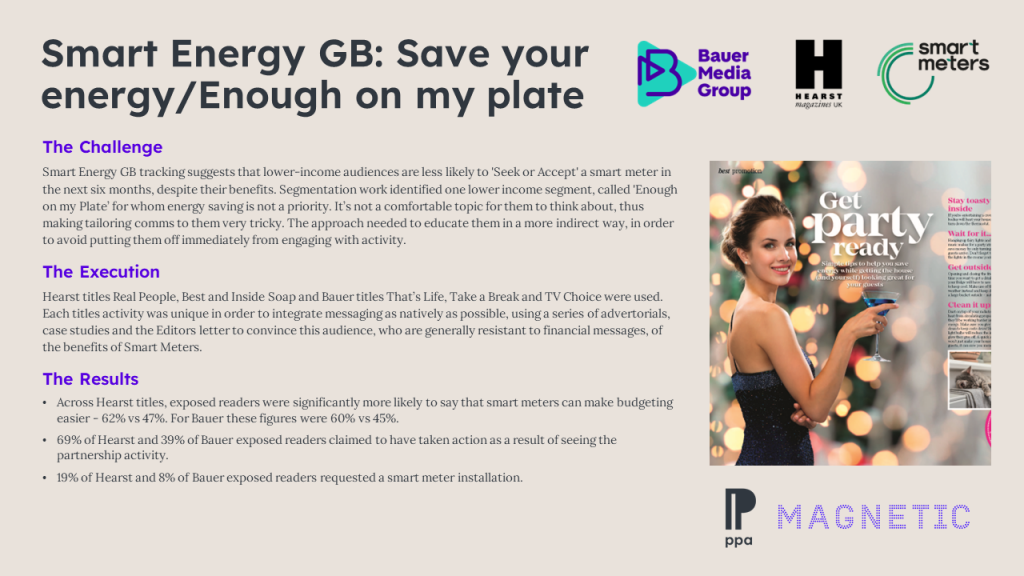Educating and driving action for Smart Energy
Key Takeaways
- Smart Energy GB needed to educate a lower income segment resistant to financial messages in a more indirect and engaging way about the benefits of Smart Meters.
- A series of Bauer and Hearst weekly titles were used to integrate messaging as natively as possible, using advertorials, case studies and the Editors letter.
- Across Hearst titles, exposed readers were significantly more likely to say that smart meters can make budgeting easier – 62% vs 47%. For Bauer these figures were 60% vs 45%.
One page summary

Client Quote
“Everyone benefits from the smart meter rollout. But arguably those on lower incomes can benefit more than most from the budgeting and money-saving that having a smart meter installed allows. But we knew that (a) teething problems with the rollout were causing people who can’t afford billing mistakes to be concerned, and (b) with the best will in the world, no one thinks getting a smart meter should be their number one priority. So we needed a channel that would deliver trust and would deliver attention. We needed magazines. We worked closely with Hearst and Bauer’s commercial and editorial teams to craft a campaign that spoke to the audience in the most relevant way possible.”
Ed Duncan, Head of Brand and Consumer Advertising, Smart Energy GB
The Challenge
Smart Energy GB tracking suggests that lower-income audiences are less likely to ‘Seek or Accept’ a smart meter in the next six months, despite the many benefits smart meters could bring them – including help with budgeting and improving their finances.
Segmentation work carried out by Smart Energy GB identified one lower income segment, called ‘Enough on my Plate’. Energy usage is not an area they focus on, in part due to a poor understanding of how being more mindful of energy consumption can help to alleviate some of their financial stress. They also find managing and planning their money quite stressful and so are hands-off; they already feel that they’re doing enough. It’s not a comfortable topic for them to think about, thus making tailoring comms to them very tricky. The approach needed to educate them in a more indirect way, in order to avoid putting them off immediately from engaging with activity.
The Plan/Execution
The segmentation work identified that this audience over-indexed against TV weeklies and gossip/celebrity weeklies and so Hearst titles Real People, Best and Inside Soap and Bauer titles That’s Life, Take a Break and TV Choice were used to activate.
With both partners, the editorial authority of these weekly titles was used to integrate Smart Energy GB messaging as natively as possible. Each brand activity was unique, tackling the challenge of landing their message with an audience resistant to financial messages in different ways:
Inside Soap – a mini-soap series ran alongside their TV listings which helped the audience visualise the benefits of smart meters in a humorous and engaging way.
Best – working closely with the editorial team, a series of advertorials were created as well as a mention in the Editors Letter (which is usually not available for paid activity).
Real People – Smart Energy took over the ‘Mum-to-Mum’ section to deliver an energy saving special, showcasing how real women were able to get control of their finances by getting a smart meter installed.
That’s Life – a successful previous editorial campaign ‘Watch Our Waste’, focused on reducing household waste, was extended to focus on energy waste. A member of the editorial team had a smart meter installed and reported on the benefits of having one.
Take a Break – three case studies of real life readers talked about the difference a smart meter had made to their lives.
TV Choice – an editorial series provided tips and tricks related to TV viewing – e.g. only boiling the amount of water needed when making a cup of tea during ad breaks. This also ran across digital properties with Hearst’s ‘Financially Fabulous’ content strand.
Results
The results show that this was the right approach as the campaign delivered against the client’s objectives; to educate and drive action:
- Across Hearst titles, exposed readers were significantly more likely to say that smart meters can make budgeting easier – 62% vs 47%. For Bauer these figures were 60% vs 45%.
- 69% of Hearst and 39% of Bauer exposed readers claimed to have taken action as a result of seeing the partnership activity.
- 19% of Hearst and 8% of Bauer exposed readers requested a smart meter installation.


